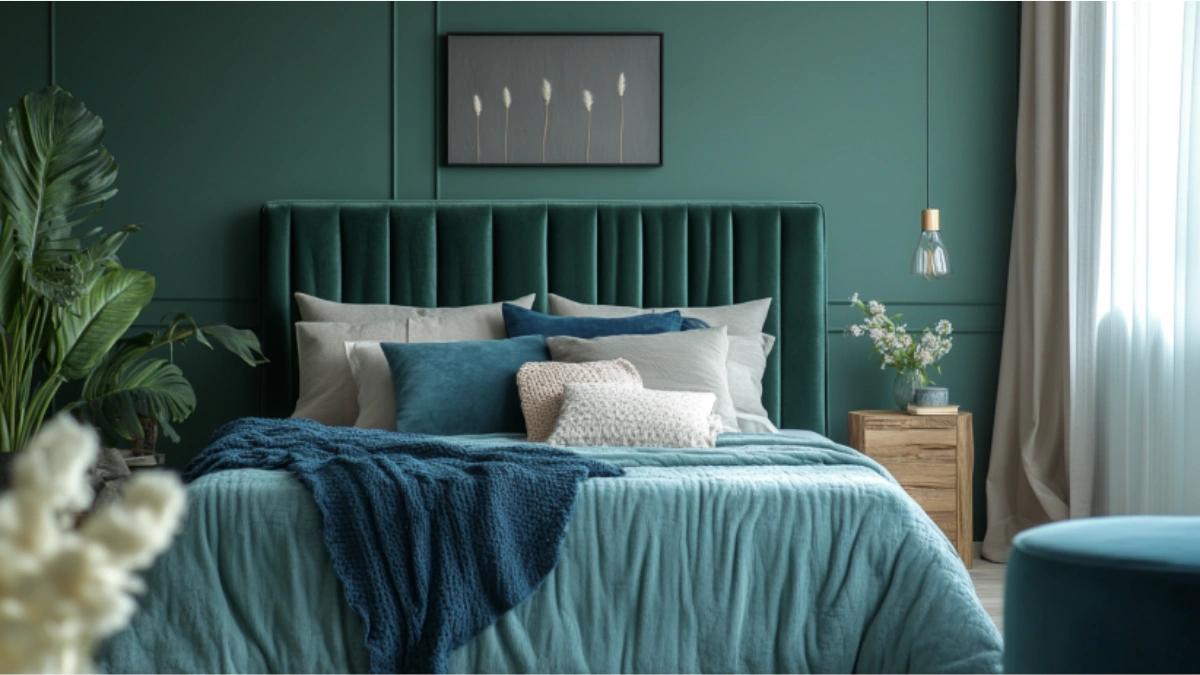How to Layer Textures in a Blue and Green Bedroom for Stunning Visual Depth
Table of Contents
When it comes to creating a serene and visually rich bedroom, color is only half the story. Texture plays a vital role in adding depth, warmth, and dimension—especially when working with a calm, nature-inspired palette like blue and green. These hues alone evoke tranquility and balance, but when paired with a thoughtful layering of textures, the result is nothing short of captivating.
From soft linens to polished metals and woven details, mixing various tactile elements brings a room to life. In a blue and green bedroom, layering becomes even more impactful as the cool tones invite contrast, subtlety, and softness through fabric and finish.
In this post, we’ll explore how to master the art of texture layering—from selecting the right textiles and furniture finishes to styling with thoughtful details. You’ll learn how to combine materials in a way that enhances the blue and green palette and transforms your bedroom into a restful yet stylish retreat. Whether you’re starting from scratch or refreshing your current space, these ideas will help you achieve a professionally designed look without overwhelming the senses.
Start with a Balanced Foundation: Walls, Flooring, and Main Pieces
Creating a visually cohesive bedroom begins with foundational choices—your walls, flooring, and primary furniture set the tone for how texture will interact within the space. In a blue and green bedroom, these surfaces can either echo the palette or provide grounding contrast.
Paint or wallpaper with matte or eggshell finishes introduces a soft visual texture, especially in dusty blues or sage greens. Pair that with natural or whitewashed wood flooring to bring in a sense of earthiness. Consider an upholstered bedframe or a velvet headboard to offer immediate depth.
Foundation Element Comparison
| Element | Material Idea | Texture Effect |
| Wall Finish | Matte sage or denim blue | Soft, calming foundation |
| Flooring | White oak or woven jute rug | Natural grounding layer |
| Bed Frame | Linen, velvet, or boucle | Adds softness and luxury |
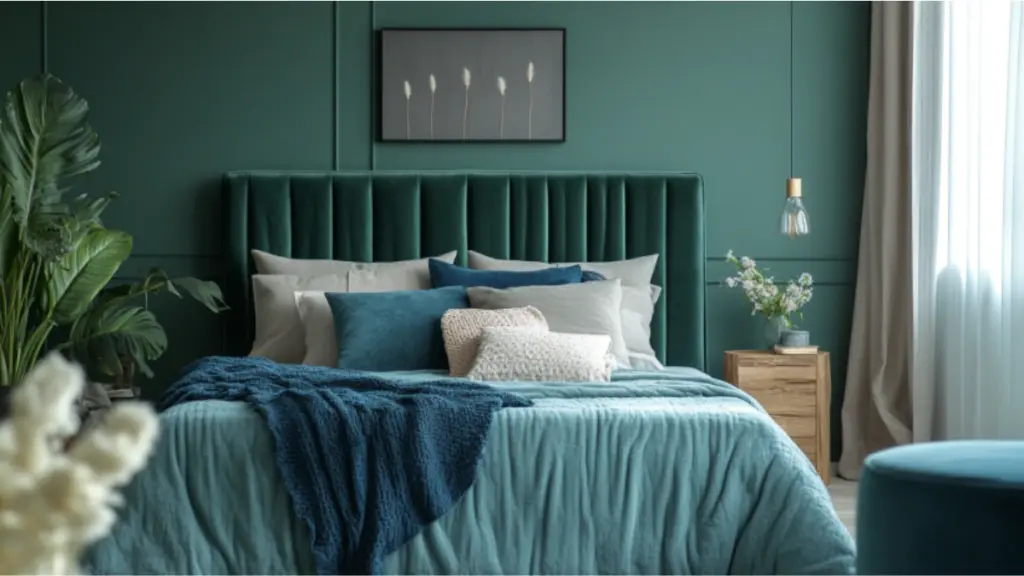
Mixing Soft Textiles: Layering Bedding, Curtains, and Throws
Textiles are one of the easiest and most effective ways to introduce texture into a bedroom. Start by layering your bedding with a variety of materials—think crisp cotton sheets, a linen duvet, a chunky knit blanket, and decorative velvet or boucle pillows.
Curtains made of sheer voile or heavy linen drape beautifully and help soften hard surfaces, while a plush throw at the end of the bed can act as a textural focal point. Don’t shy away from mixing materials; it’s this contrast that creates visual richness.
Bedding Layering Breakdown
| Layer | Fabric Type | Purpose |
| Base Sheets | Cotton or bamboo | Breathable and smooth |
| Duvet Cover | Linen or sateen | Textured visual base |
| Throw Blanket | Knit or faux fur | Cozy contrast + warmth |
| Accent Pillows | Velvet, boucle | Decorative + tactile interest |
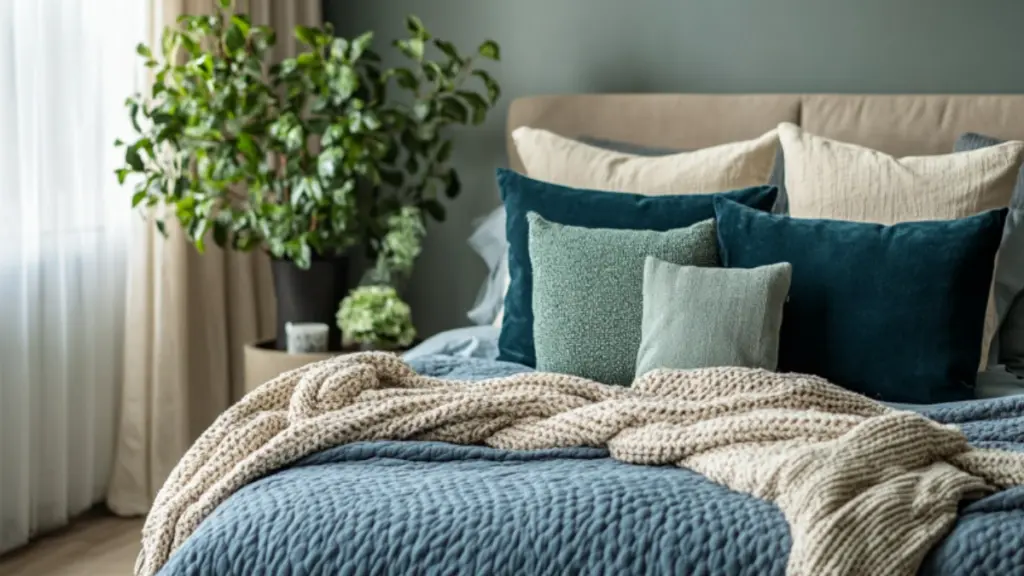
Incorporate Natural Materials: Wood, Rattan, and Stone Accents
To elevate your bedroom’s depth, infuse it with natural materials that balance the cool tones of blue and green. Wood adds warmth, rattan brings a light organic feel, and stone or concrete offers visual weight and subtle patterning.
Choose a wooden nightstand with visible grain, a rattan light fixture, or a marble-topped side table. These details create subtle but effective layers that keep the room from feeling flat or sterile.
Natural Material Ideas for Texture
| Item | Material | Texture Role |
| Nightstands | Raw or stained wood | Adds warmth and grounding |
| Pendant Lights | Woven rattan | Softens light, adds airiness |
| Accent Tables | Marble or stone | Adds cool elegance and polish |
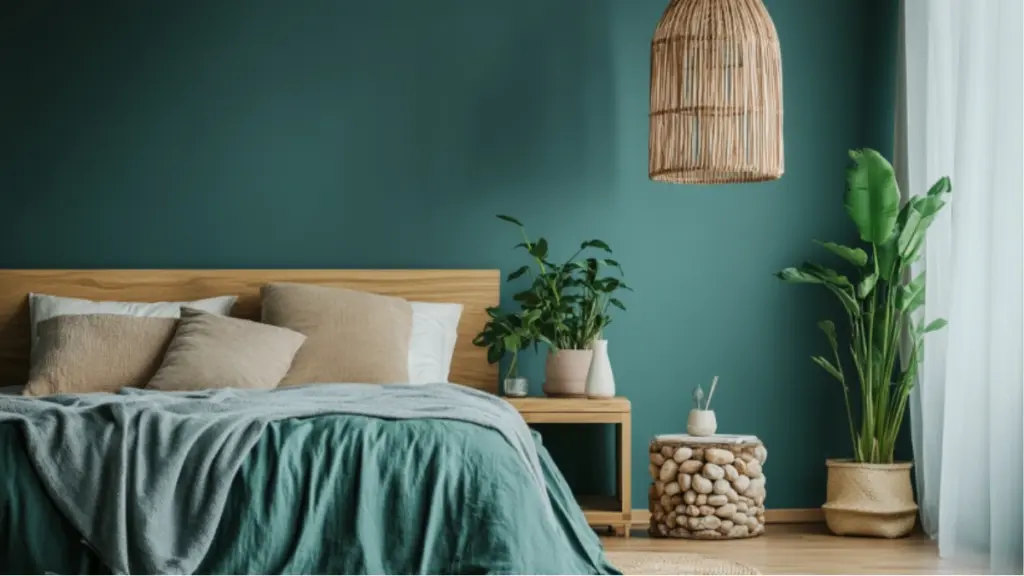
Play with Contrast: Smooth vs. Rough, Shiny vs. Matte
A room full of one texture can feel one-dimensional, no matter how beautiful the color palette. Contrast is key to layering textures successfully. Pair a high-gloss ceramic vase with a rough jute rug or a sleek metal lamp with a soft wool throw.
These pairings create visual tension and keep the eye moving. Be intentional—choose one or two bold contrasts per zone, such as a bedside area or reading nook, to make the effect feel curated rather than chaotic.
Contrast Pairing Examples
| Smooth Element | Contrasting Texture |
| Glossy blue ceramic lamp | Woven jute nightstand mat |
| Satin green bedspread | Chunky cable knit pillow |
| Polished brass frame | Matte canvas wall art |
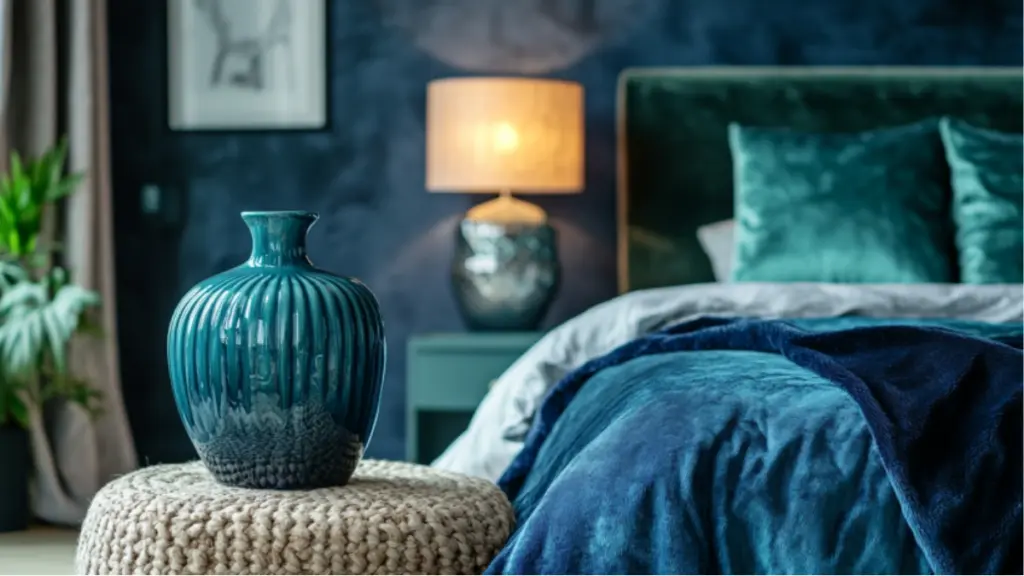
Add Layers with Decor and Accessories
Once your foundation and key furnishings are set, the final textural story is told through accessories. This is where your personal style can shine while still supporting the layered look. Think about layering small decor items by size, material, and color intensity to avoid visual flatness.
For example, a gallery wall can mix canvas, wood frames, and metal prints to add depth. Layer trays on dressers with ceramics, books, and greenery to keep the eye engaged. Even practical items like lamps or alarm clocks can be chosen for their finish—matte black, brushed nickel, or glazed stoneware.
Don’t overlook what’s underfoot either. A layered rug approach—placing a patterned textile over a jute base rug—adds instant richness without overwhelming the space.
Decor Layering Strategy
| Decor Type | Suggested Material | Textural Value |
| Wall Art | Canvas, wood, metal | Adds height + varied texture |
| Tabletop Décor | Glazed ceramic, raw wood | Tactile contrast and color pop |
| Area Rugs | Layered (jute + wool blend) | Grounding + dimensional softness |
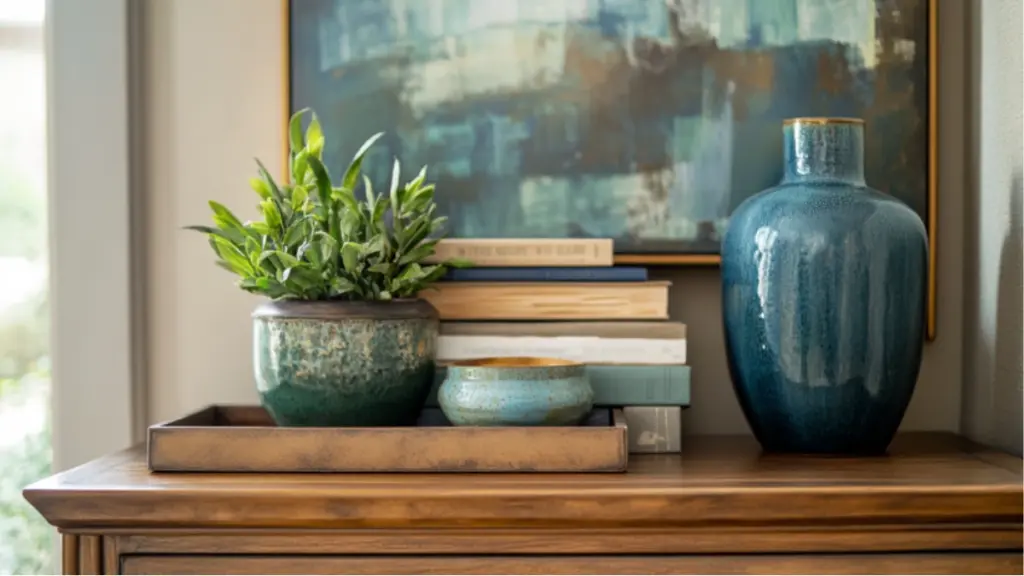
Use Lighting to Highlight Texture
Lighting does more than illuminate—it enhances every texture in your bedroom. Soft ambient light can bring out the richness of velvet and the depth of wood grain, while directed task lighting emphasizes details in bedding or art.
Mix lighting types for layered impact: ambient (overhead), task (reading lights), and accent (decorative lamps or string lights). Also consider the bulb temperature—warm white bulbs are flattering for earthy textures and blue-green hues, while cooler tones may work for modern or minimalist styles.
Using lamps with tactile bases—ceramic, glass, woven—can double up as both light source and décor.
Lighting Types and Texture Enhancement
| Light Type | Fixture Material | Texture Benefit |
| Ambient | Rattan pendant or drum shade | Softens and spreads textures |
| Task | Brushed metal or ceramic base | Sharpens detail, directs focus |
| Accent | Glazed table lamp or wall sconce | Highlights texture-specific zones |
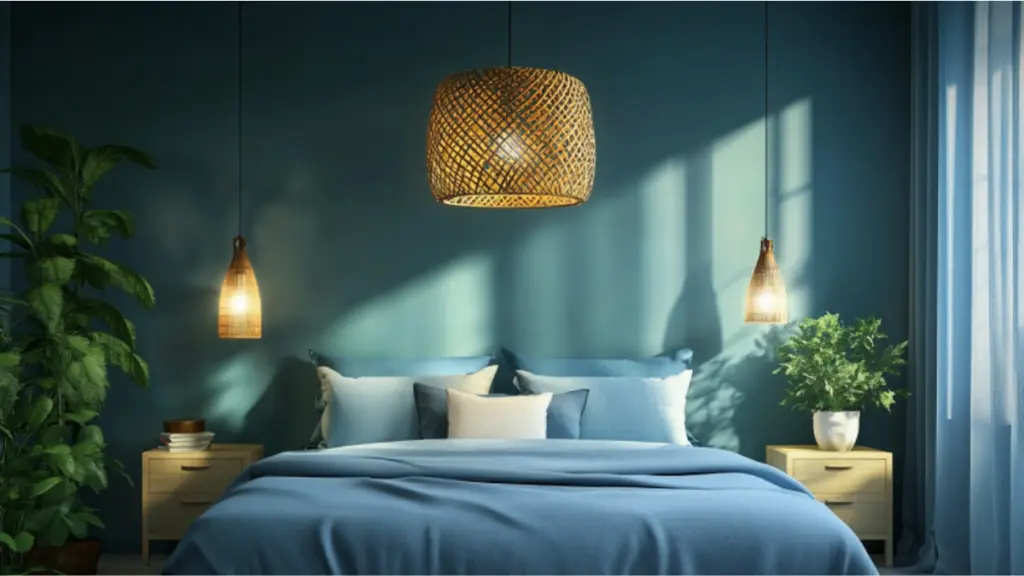
Balance Color and Texture: Avoid Overwhelm
Layering textures in a blue and green bedroom is all about subtlety. Stick to a controlled color palette to avoid clashing elements. Shades like navy, sage, seafoam, and teal can coexist beautifully, but use texture to differentiate rather than more color.
If you’re incorporating patterned elements, such as a botanical pillow or a geometric rug, let the texture support it rather than compete. Visual calm is achieved when each element feels intentional—not crowded.
Color + Texture Coordination Tips
| Color | Best Textures to Pair | Mood Created |
| Navy Blue | Velvet, leather | Rich, moody, grounded |
| Sage Green | Linen, brushed cotton | Soft, airy, and fresh |
| Seafoam/Teal | Glass, ceramic, smooth wood | Clean, coastal-inspired |

Conclusion
A blue and green bedroom already speaks to nature’s calming presence, but when you thoughtfully layer textures, you unlock a new level of visual richness and depth. From the foundational elements like walls and flooring to the detailed touches of decor and lighting, each texture works together to create a room that’s as comforting as it is stylish.
By combining smooth and rough, shiny and matte, organic and refined, you create a symphony of sensation that transforms your space from ordinary to unforgettable. With these strategies, your bedroom becomes more than a place to rest—it becomes an experience of serenity, intention, and refined design.

